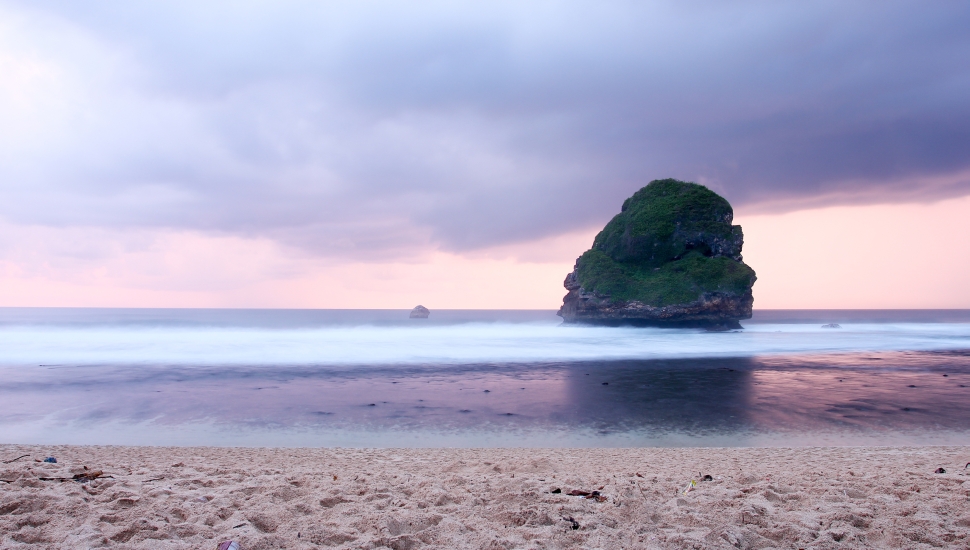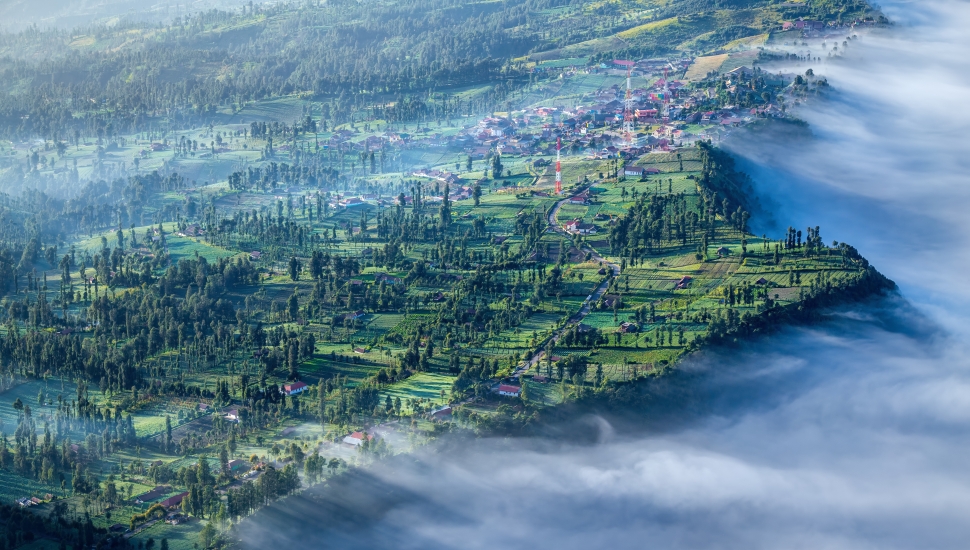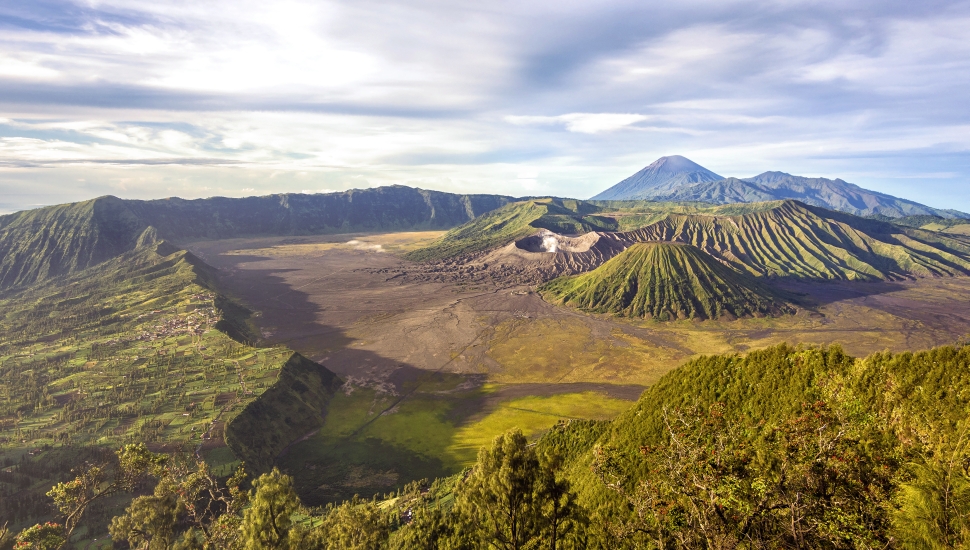Mt Bromo and the Sea of Sand – by Scooter
Java's Volcanic Mount Bromo, surrounded by the vast Sea of Sand, is not ideally suited to small motorcycles – as Craig Hindmarsh and his companions soon learned.
2,329m Mount Bromo is the most famous peak in the Tengger Massif, East Java. Its status as an active volcano continues to lure thousands of visitors each year. Adding to the mystique of Bromo is the Yadnya Kasada ceremony, during which the Tenggerese people of nearby Probolinggo bring offerings of vegetables, fruit, flowers – and even livestock. These they cast down into the caldera, in an annual Hindu ritual which dates back to the 15th Century.
Like many before us, we arrived in the bustling city of Malang with a plan to see Mount Bromo and its famous Sea of Sand.

All three of us were exploring Indonesia on tight budgets, so we were keen to find the most economical way to see Bromo. After discounting tours and the possibility of hiring an angkot for the day (both due to cost), we chose to rent motorcycles.
But finding two wheeled steeds was not easy. Despite Malang containing tens of thousands of motorcycles, the local rental shops seemed reluctant to help us. Even our guest house gave mixed signals about renting bikes, before informing us it wasn't possible. The reason, it seemed, was that the sandy, off-road tracks around the Tenggurr Massif put a great deal of strain on a motorbike's moving parts.
However, we eventually found a smiling young man outside the train station who was willing to rent us three 125cc motorbikes. Citing altitude, he doubled what it should have cost, but, eager to see Mount Bromo, we agreed to his fee.
Heading eastwards we stopped briefly at an old lady's shop to top up our tanks: she poured bottles of blue-coloured petrol into each bike at 8000 rupiah (50p) a litre.
The buildings and noise of Malang soon gave way to peaceful paddy fields and verdant jungle. Locals smiled warmly as we relaxed into the ride.
Soon we were climbing and the temperature began to drop. Luckily, we had all taken plenty of layers to keep us warm.
We paused briefly at a layby overlooking a deep tree-covered ravine, its majestic Alpinesque features contrasting sharply with the constant traffic of Malang. We pulled the clean air deep into our lungs before continuing our ascent.

At the entry gate a grinning Indonesian directed us to a little kiosk where we were each relieved of 220,000 rupiah (£14), which, as with many other natural attractions in Indonesia, contrasted starkly with the price for locals (in this case 37,000).
Proceeding into the national park, we rose up into cool mist before plunging down into something like a U-shaped valley, where the tarmacked road abruptly ceased. The southern flank of this deep channel was steep sided and green, while the north was a series of decidedly volcanic ridges. The trough was covered in light green rustling grasses, reminding me of American prairies.
Stopping often to take photos of our wondrous surroundings, we moved towards Mount Bromo. Soon the dirt track gave way to volcanic sand and our small motorbikes began slipping around.
The grasses died way. This vast area was known, quite rightly, as the Sea of Sand. The charcoal grey desert stretched out for miles. Our olfactory senses became dominated with the smell of sulphur.
Sitting bedside Bromo was Mount Batok, a more classic volcano shape. It lent the scene a science fictional quality. It seemed preposterous that we could reach such a place after a mere two-hour motorcycle ride from civilisation: surely arriving at such a wilderness required weeks of arduous travel?

Leaving trails of sand dust we moved east, occasionally passing groups of Indonesian bikers who smiled and whooped at us; few foreigners would venture into these lands unless they were in a Jeep tour.
Soon we were rising again, past farmers carrying bamboo and cabbages on the backs of puttering old scooters.
Our prime destination of the Mount Bromo viewpoint 1, which we found without too much trouble. Parking up, we gazed in awe at the vista in front of us. Visibility wasn't perfect, but the mist and cloud cover added a certain drama to the scene. Coming from a country with no active volcanoes at all, such a view is most absorbing.
After an hour or so, we began our return trip to Malang. But my companions suggested taking a different, more circuitous route back. I was a little concerned about our petrol reserves, but in the interests of adventure, agreed.
I was glad I did. The return trip was even more other-worldly. The sand became softer and harder to navigate, while dark clouds formed over the ridge ahead. Rising up into the green lips of the ancient caldera it began drizzling, then, arriving at a kind of cross-roads, we found ourselves lost.
Donning our ponchos, we were about to go the way we had come – a move which may have seen us stranded on the dark sand without petrol. But the distant sound of a dirt bike made us pause. An Indonesian biker emerged from around a slope and stopped, with the obligatory native smile, before asking us where we were going. We said Malang. He told us to follow him.
For me, the route that followed was even more memorable than the volcanoes. We careered along a mountain-hugging dirt track, enclosed by tall grasses and vertiginous farmland. Mist and light rain enveloped us as we strove to keep apace with our impromptu guide. It was a very bumpy ride and I understood the reluctance to rent us what were basically street scooters for a thoroughly un-tarmacked trip.
After perhaps an hour of this most enjoyable of off-road rides, we found the main road to Malang. Bidding our guide goodbye, we continued down towards the city, the cool tranquillity of the volcanoes gradually replaced by the heat and clamour of a thousand scooters.
Get a Quote